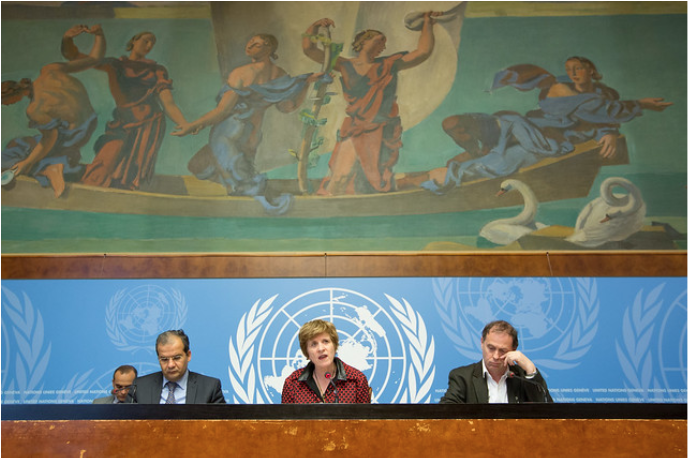
The United Nations Art Collection

“But only art and music have the power to bring peace.” -Yoko Ono
Just as you may curate the art in your home, the United Nations collects and displays artwork meaningful to its Member States and to the international community. Each year proposals for donations from Member States are presented to the UN Cultural Activities Committee. This committee oversees all proposals, the processes behind accepting the works, and approves or denies the proposal based on whether the piece fits with UN principles and is able to be properly displayed.
The United Nations art collection is developed through donations just as many museums art collections are through donation or loan. The United Nations collections do not focus on certain time periods or regions, rather they are shown together regardless of time period or geography. Instead, the thing that ties the art together is the fundamental idea that, according to the United Nations Office at Geneva, “Within the United Nations, art does not exist only for its aesthetic values. It also serves one of the Organization’s major goals, the promotion of the unity of humankind in all its cultural diversity.”
Pieces of note at the United Nations New York Headquarters
Chagall, Marc. Peace. 1964, United Nations New York City. Stained Glass.
Photo by United Nations Photo
The most prevalent theme across the collection is peace and love. The 15 by 12 foot Peace by artist Marc Chagall illustrates those main values of the United Nations in stained glass.The piece was created as a tribute to former United Nations Secretary-General Dag Hammarskjøld, who died in 1961 in a plane crash en route to negotiate a ceasefire in the Congo crisis. The mural depicts two sides. On the left side humans and animals living in a peaceful world. The right side shows humans struggling for peace. Throughout the piece there are music symbols that allude to Beethoven’s Ninth Symphony, which was a favorite of Hammarskjøld’s.
Vuchetich, Yevgeny. Let Us Beat Swords into Plowshares. 1959, United Nations New York City. Bronze.
Photo by United Nations Photo
The theme of peace is continued in this sculpture, presented to the United Nations by the Soviet Union in 1959. This piece illustrates ending wars and turning a weapon of destruction into a weapon to sow life. The title of the piece comes from the Book of Isaiah 2:3: “And he shall judge among the nations, and shall rebuke many people: and they shall beat their swords into plowshares, and their spears into pruning hooks: nation shall not lift up sword against nation, neither shall they learn war any more.” The sculpture is displayed in the gardens on the property of the United Nations Headquarters in New York City.
Reuterswärd, Fredrik. Non-Violence. 1980, United Nations New York City
Photo by mira66
In 1988, the government of Luxembourg donated one of the first 3 replicas of the sculpture titled Non-Violence, more commonly known as The Knotted Gun. Non-Violence was originally placed in the Strawberry Fields section of Central Park in New York City as a tribute to John Lennon. According to the Permanent Mission of Luxembourg to the United Nations, “with Non-Violence, Carl Fredrik Reuterswärd has not only endowed the United Nations with a cherished work of art; he has enriched the consciousness of humanity with a powerful symbol. It is a symbol that encapsulates, in a few simple curves, the greatest prayer of man: that which asks not for victory, but for peace.” The bronze sculpture depicts a Colt Python 357 magnum revolver with the barrel tied in a knot. Even though the gun is cocked, it will never fire. The piece has been reproduced and replicas of Non-Violence are spread across the world. Today artists, celebrities and public figures recreate the statue to raise money for the Non-Violence for Peace Tour. Replicas are shown at events and galleries around the world.
After the success of the Second World Conference on Arts Education in Seoul in 2010 UNESCO Resolution 36/C55 declared the fourth week of May as the International Arts Education Week. This year, International Arts Education week is May 20-26. Take some time this week to visit a museum or art gallery near you, or take a class, see if you can find (or make!) pieces that would fit with the United Nations themes of peace and love.
Keep Up With The Accords
More to read
The AMUN Accords is a premier resource for fact-based Model United Nations simulations. We are always looking for new contributors. Want to write for the AMUN Accords? Check out out the submission guidelines and then get in touch!







